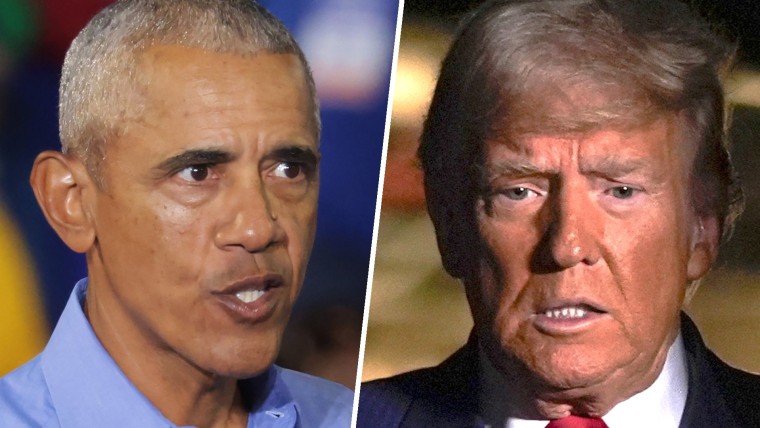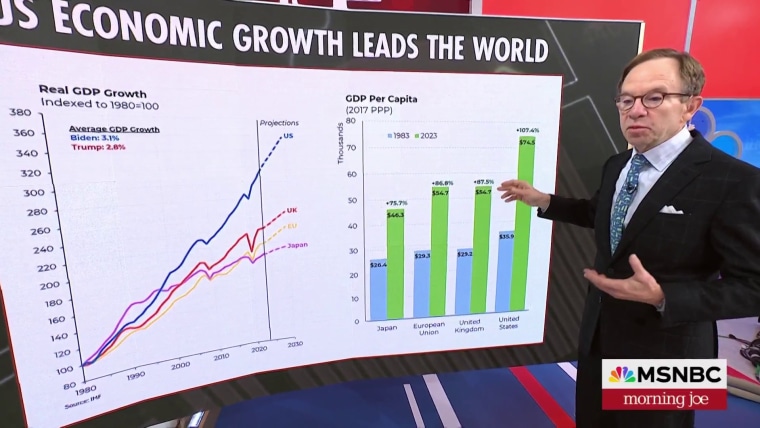It has never been easy to navigate the line between taking Donald Trump too seriously and not seriously enough. Sometimes his rantings are just Trump being Trump. Other times, they become frighteningly real.
With the outcome of next week’s election uncertain, then, it’s vital to determine what Trump will really do if he becomes president. That means considering both the proposals he and those around him have actually thought through and the half-baked notions he tosses off. The latter must be included because, in a new Trump administration, he’ll be surrounded by sycophants who are busy dismantling the guardrails that have so long protected our system from the capricious use of presidential power. Even his most preposterous and perilous proposals could find their way into law in some form.
A spike in prices could come even before Trump’s tariffs take effect.
Just as Trump is even more hateful and erratic today than he was in years past, his economic plans have become more ill-conceived. And the ones he cares most about — the ones he’d push hardest to implement — are the most dangerous. His biggest billionaire supporters, including Elon Musk, are already warning of the “hardship” to come.
Atop the list is his plan for across-the-board tariffs on foreign goods. These are not targeted tariffs to boost particular domestic industries, which have been common throughout our history, but huge tariffs on everything we import. “To me, the world’s most beautiful word in the dictionary is tariffs. It’s my favorite word,” he says. At various times he has proposed 10% or 20% tariffs on all imports, and a 60% tariff on all goods from China.
Trump, with his customarily poor grasp of basic economics, claims that “foreign countries” pay these tariffs. In fact, tariffs are paid by American consumers and importers — and the latter usually pass the cost onto consumers. Even Cantor Fitzgerald CEO Howard Lutnick, the co-chair of Trump’s transition team, admitted on CNBC that tariffs will raise prices.
So how much would we pay? The U.S. imported more than $3 trillion worth of goods in 2023. A 10% or 20% rate means hundreds of billions of dollars in increased costs to Americans. An analysis by the Yale Budget Lab estimated that Trump’s tariff policy would cost every American household somewhere between $1,900 and $7,600 per year. And other countries would inevitably respond to Trump’s across-the-board tariffs with their own. That would spark a global trade war that would crush American exports, leading to massive job losses.

A spike in prices could come even before Trump’s tariffs take effect. The Washington Post reports that across the country, “companies that rely on foreign suppliers are preparing to raise prices in response to the massive import tariffs that former President Donald Trump promises if he wins the election.”
Then there’s the mass deportation that is close to Trump’s heart. On top of the almost incalculable human cost, a report from the American Immigration Council estimates that mass deportations would shrink the nation's GDP by at least 4.2% — a blow equal to what the country suffered during the Great Recession.
Trump also wants to extend the tax cut he signed in 2017. Since it was a Republican plan, it gave most of its benefits to corporations and the wealthy, and they’re the ones who would benefit most from extending it. According to the Penn Wharton budget model, those in the top 0.1% of earners would gain an average of $376,910 in just the first year of Trump’s policy changes.
The radical nature of Trump’s economic plans is particularly head-spinning given how well the American economy is doing right now.
Almost every economic policy Trump proposes would, at best, do little for the middle and working classes and, at worst, outright harm them. To take one example, among the random suggestions Trump has made is to make car insurance interest tax deductible. But that would only benefit you if you already itemize your deductions, and only 10% of taxpayers itemize, most of whom are wealthier. The rest of us take the standard deduction, which was significantly increased in that 2017 tax cut Trump wants to extend.
The radical nature of Trump’s economic plans is particularly head-spinning given how well the American economy is doing right now. Our recovery from the pandemic has made us what The Economist — hardly a bastion of liberal advocacy — calls “the envy of the world.” America's GDP grew at a 2.8% annual rate in the third quarter, driven by strong consumer spending. The recession many believed was inevitable just two years ago never occurred. Unemployment is low. Inflation has reached three-year lows, closing in on the Fed’s 2% target. The economy has added more than 16 million jobs since President Joe Biden took office, a record for a single presidential term.
Americans still face fundamental economic difficulties — but Trump would do almost nothing about any of them. His idea for the housing affordability problem is to sell off some federal land to developers, even though the housing problem isn’t that developers can’t find empty tracts to build on. He still wants to dismantle Obamacare, which would throw millions off their health care plans. A longtime enemy of labor unions, he would crush Americans’ ability to bargain collectively for better wages and benefits.

That doesn’t even cover the way Trump is eager to implement a program of crony capitalism, punishing companies that displease him and rewarding those that pay him tribute. The billionaires closest to him are embracing the worst of his plans — or itching to go even further.
“When was America great?” Lutnick asked the audience at Trump’s Madison Square Garden rally Sunday. “At the turn of the century... We had no income tax. And all we had was tariffs.” Trump has suggested appointing Musk to lead a “government efficiency commission.” Musk says he would target $2 trillion in spending cuts, which even he acknowledges will “involve some temporary hardship.” These moguls are willing to let the rest of us suffer to seize control of the economy for their own whims.
Trump made economic mistakes in his first term — the trade war he started was disastrous for farmers, and the rest of us had to bail them out to the tune of more than $60 billion — and whatever success he had came mostly from just leaving things alone. That is definitely not the plan for his next term. If he has his way, we’ll face a new eruption of inflation, more economic uncertainty and a system in which whether you get rewarded or punished is based on whether you genuflect before Trump.
The good news is that voters may be noticing. Recent polls have shown that voters are now about as likely to say they trust Kamala Harris as Trump on the economy, erasing a lead he had held for most of the campaign. Perhaps enough people are taking a look at what Trump wants to do that he’ll never get a chance to do it.

